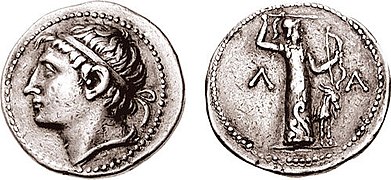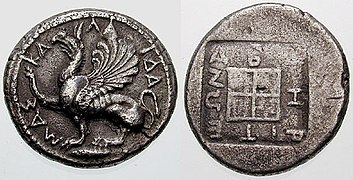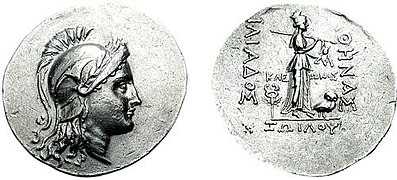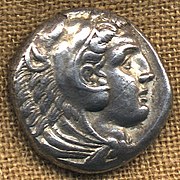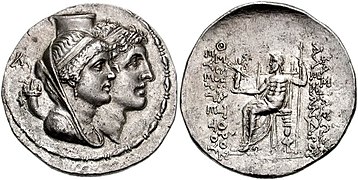Tetradrachm

Thetetradrachm(Greek:τετράδραχμον,translit.tetrádrachmon) was a large silver coin that originated inAncient Greece.It was nominally equivalent to fourdrachmae.[1]Over time the tetradrachm effectively became the standard coin of theAntiquity,spreading well beyond the borders of the Greek World. As a result, tetradrachms were minted in vast quantities by various polities in many weight and fineness standards, though theAthens-derivedAttic standardof about 17.2 grams was the most common.
Because of their large size, tetradrachms were often used by various states or rulers to advertise themselves or to deliver political messages. Popularity of the tetradrachm outlived the political independence of the Greeks and it remained in wide circulation in the Mediterranean up untilCrisis of the Third Century,while debased varieties persisted inIndiaandCentral Asiainto earlyMiddle Ages.
Due to their often high artistic level tetradrachms areeagerly collected in modern times,and well-preserved or rare specimens can reach considerable prices.
In Athens[edit]
In Athens it replaced the earlier "heraldic" type of didrachms and it was in wide circulation fromc. 510toc. 38 BC.[2]

The transition fromdidrachmsto tetradrachms occurred duringc. 525–510 BC; the abandonment of the "heraldic" -type didrachms and the Archaic tetradrachms (early "owls" ) of thepolisofAthensapparently took place shortly after theBattle of Salamis,480 BC. This transition is supported by the discovery of contemporary coin hoards, and more particularly of a coin hoard found on the Acropolis in 1886.[citation needed]
The Athenian tetradrachm was widely used in transactions throughout the ancient Greek world, including in cities politically unfriendly to Athens.[2]Athens hadsilver minesin state ownership, which provided thebullion.Most well known were the silver mines ofLauriumin Athenian countryside.[3]The Athenian tetradrachm was stamped with the head ofAthenaon theobverse,and on the reverse the image of theowl of Athena,the iconographic symbol of the Athenian polis, with a sprig ofoliveand a crescent for the moon. According toPhilochorus,it was known asglaux(γλαύξ,'little owl')[4]throughout the ancient world[5]and "owl" in present-day English languagenumismatics.[6]The design was kept essentially unchanged for over two centuries, by which time it had become stylistically archaic. To differentiate theircurrencyfrom the rival coinage ofAeginausing the Aeginetic stater of about 12.3 grams, Athens minted its tetradrachm based on the "Attic" standard of 4.3gramsper drachma. The vast number of "owls-tetradrachms" available those days mainly from the silver mines of Laurium financed the several achievements of Athens, such as the reconstruction of theAcropolisand building theParthenon,as well as many wars, including thePeloponnesian War.
In other polities[edit]
The tetradrachm's use as a currency was soon adopted by many other city-states of the ancient Greece,Asia Minor,Magna Greciaand other Greek colonial cities throughout theMediterranean Sea.With the armies ofAlexander the Greatit spread to otherGreek-influenced areasof Asia.
Tetradrachms were common as trade coins.[7]
-
Tetradrachm ofOlympia
-
Tetradrachm ofSparta
-
Tetradrachm ofAbdera
-
Tetradrachm ofTroy
-
Tetradrachm ofKyme
-
Tetradrachm ofRhegion
-
Tetradrachm ofNaxos
-
Tetradrachm ofAetna,5th C. BC
-
Tetradrachm ofAlexander the Great
-
Tetradrachm ofCleopatra Thea
See also[edit]
References[edit]
- ^"Tetradrachm".Merriam-Webster.Retrieved2008-01-20.
- ^abAndroulakis, Yiannis."History of the Greek coins".Fleur-de-Coin.Retrieved2008-01-20.
- ^Aristotle,Athenian Constitution,22.7
- ^γλαύξ,Liddell & Scott
- ^Philochorus: Scholion to Aristophanes,Birds1106.
- ^Kraay, C.M. The archaic owls of Athens: classification and chronology.
- ^Otto Mørkholm (31 May 1991).Early Hellenistic Coinage from the Accession of Alexander to the Peace of Apamaea (336–188 BC).Cambridge University Press. p. 8.ISBN978-0-521-39504-5.
External links[edit]
- Pictures of Athenian tetradrachms(archive)
- Tetradrachms from Sicily, Syracuse -The Demareteion Tetradrachm



